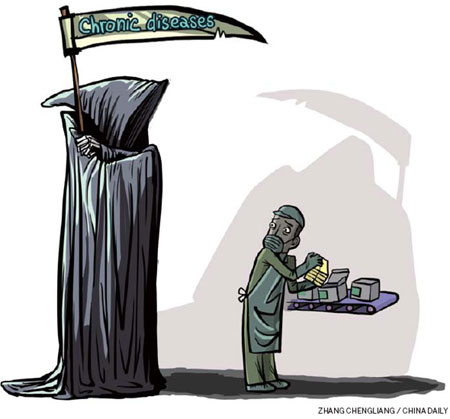United response needed to check the spread of chronic diseases
Updated: 2011-09-02 10:17
By Yanzhong Huang (China Daily)

China and other emerging economic powers can play a leading role
Born in a small village by the Yangtze River, I witnessed how the Maoist health system, with its commitment to equity and universal access, successfully brought down the incidence of infectious diseases and significantly improved public health.
I saw how in the 1970s most people just hoped for a bowl of rice, but relatively few died of stroke, diabetes, cancer or heart disease.
Much like tuberculosis - which was seen by some in the 19th century as an expression of beauty and creativity from those infected - chronic, noncommunicable diseases were long considered ailments of affluence in rich countries.
Not anymore.
With globalization, urbanization and economic growth, noncommunicable diseases are the major cause of death and disability, even in the developing world. Since the 1980s, lower- and middle-income countries have seen the rapid rise of fat intake, which is associated with heart disease. These populations are aging faster, increasing the likelihood of people developing chronic diseases later in life.
According to the World Health Organization, nearly 80 percent of chronic diseases today occur in low- and middle-income countries. The burden of noncommunicable diseases is particularly high for emerging economic powers like Brazil, Russia, India and China, which together with South Africa are known as BRICS.
Around 85 percent of deaths in China, 81 percent in Russia, 75 percent in Brazil and 53 percent in India are caused by chronic diseases. Even in South Africa, where HIV/AIDS is the leading killer among adults, the burden of chronic disease is growing.
BRICS as a group is leading a global explosion of diseases such as diabetes. According to recent research in the medical journal The Lancet, 138 million of those with diabetes - or 40 percent of the world's diabetes population - live in China and India. And China overtook India to be the diabetes capital last year. As one epidemiologist put it, for every person worldwide with HIV/AIDS, there are three people in China with diabetes.
The epidemic of noncommunicable diseases bodes ill for development. Research shows that a 10 percent increase in chronic disease is associated with a 0.5 percent decrease in annual economic growth. A report from the World Health Organization found that Brazil, China, India and Russia together currently lose more than 20 million productive life years annually to chronic disease.
As Dr Harvey V. Fineberg, president of the Institute of Medicine in the US, noted, chronic disease may cost China, India and Russia $200 billion to $500 billion (138 billion euros to 345 billion euros) in national income from 2005 to 2015. In India alone, chronic disease pushes 40 million people below the poverty line each year.
The United Nations General Assembly will hold a meeting on noncommunicable diseases in September. But there is little evidence to suggest that there is a paradigm shift in disease prevention and control. According to a senior American government official, Washington has no plan to shift from the existing Millennium Development Goals, which include a commitment to reducing infectious diseases. And the Bill & Melinda Gates Foundation seems to have little interest in shifting its funding priorities from infectious to noncommunicable diseases. So far, no heads of state from BRICS have made commitments to attending the UN meeting.
BRICS must place a strong emphasis on tobacco control and shared risk factors like salt reduction. But these countries are further hamstrung by a health crisis on two fronts: the sharp rise in noncommunicable diseases and the tremendous challenges of infectious disease.
India and China lead the world in the incidence of tuberculosis. In handling the threat of infectious diseases, they tend to rely on disease-specific programs financed by international donors. This has distracted governments from strengthening overall health systems, which is essential to reversing the chronic disease epidemic.
Systemwide public health interventions are indeed costly, but the price of inaction is even more staggering.
Ensuring access for all to affordable, quality health services is an indispensable and cost-effective approach for BRICS to move the chronic disease agenda forward.
While the growing economies in these countries can provide sufficient funding to give everyone access to healthcare, improved coverage would stimulate domestic demand by freeing more money that would otherwise be spent on footing expensive medical bills.
Brazil and Russia have made significant strides in achieving universal healthcare, and China has pumped in massive funding to ensure universal access to primary medical care by 2020.
The South African government recently announced its proposal for a universal healthcare system to start next April, while a movement is under way to push India to follow suit.
Now is the time for BRICS to elevate universal health coverage in the fight against noncommunicable diseases. BRICS should tap into the power of their robust biotechnology and pharmaceutical industries and form a partnership on the development and production of affordable drugs that can truly benefit people in the developing world.
Yanzhong Huang is a senior fellow for Global Health at the Council on Foreign Relations and associate professor at the John C. Whitehead School of Diplomacy and International Relations, Seton Hall University, New Jersey. The opinions expressed in the article do not necessarily reflect those of China Daily.
E-paper

City's dynamic teutons
German cluster gives a fillip, competitive edge to local economy in Taicang
Short and sweet
Game for growth
Character reference
Specials

Hunting grounds
Opinion divided as China debates opening door to international players

Flying the TCM flag
A small German town is home to Europe's flagship clinic for traditional Chinese medicine

Animal attraction
World's youngest chief fur designer set to launch own label and tap into huge China market.
